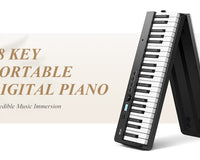Playing the piano isn't just about practicing; it is a focused and structured practice that produces tangible results. The piano journal is a valuable tool that is often overlooked. Whether it's a physical notebook or a digital journal, a piano journal acts like a compass, guiding you along your musical journey and accelerating your progress in many ways.
Understanding the Piano Journal
What is a piano log?
A piano journal is a documented record of your piano practice sessions. It serves as a practice logbook, recording practice details, reflections, challenges, and accomplishments during each session.
Benefits of Writing a Piano Journal
- Track progress: By systematically documenting your workouts, you will have a clear overview of your development over time. It helps identify areas for improvement and offers encouragement when reflecting on past achievements.
- Accountability and Consistency:It instills discipline and accountability in your practice routine. By setting goals and recording your efforts, you're more likely to stick with your training program.
- Reflective learning: Reflecting on your practice sessions allows you to analyze what works and what doesn't. This self-assessment promotes better learning and helps you refine your practice methods.
- Inspiration and creativity:A Piano Journal is not just about the practice of logging; it’s also a creative outlet. It's a space to jot down musical ideas, inspirations and thoughts, thereby nourishing your creativity.

How to start writing a piano journal
- Set specific goals: Start each workout with specific goals in mind. Describe the techniques, pieces or exercises you want to work on.
- Document your practice: Record details of what you practiced, areas of interest and challenges encountered. Include any advancements or improvements made during the session.
- Reflect and review: take time to reflect on your practice. Write down your feelings, your successes, and areas you need to focus more on.
Physical notebook or digital journal?
Physical notebooks and digital journals offer unique benefits when keeping a piano journal:

Physical notebook:
- Tangible experience: Writing by hand can provide a tactile connection that improves memory retention and emotional expression.
- Personalization: Personalize your planner with sketches, doodles and handwritten notes, allowing creativity and a sense of ownership.
- Reduced Screen Time: Away from screens, using a physical laptop provides a break from digital devices, reducing eye strain and screen fatigue.
- Portability: Easy to carry, allowing you to write down ideas or thoughts whenever inspiration strikes, without relying on technology.
Digital Journal:
- Accessibility: Access your calendar across multiple devices such as phones, tablets and computers, ensuring your entries are always available and backed up.
- Multimedia integration: Insert photos, audio recordings or videos to complement written entries, adding depth and visual representation.
- Organization tools: Use features like tags, categories, and search functions for better organization and quick retrieval of specific entries.
- Editing flexibility:Easily edit, rearrange or add entries without worrying about clutter or errors, providing a cleaner, neater record.
- Security:Many digital platforms offer password protection or encryption, ensuring the privacy and security of your entries.
Choosing between a physical notebook and a digital journal ultimately depends on your personal preferences, habits, and how you plan to use and interact with your piano diary. Some people prefer the tactile nature of a physical notebook, while others enjoy the versatility and accessibility of a digital journal. Experimenting with both can help you determine which format best suits your needs and preferences for your piano journal.

Structuring Your Piano Journal
- Date & Time: Save the date and time of your workout.
- Practice Goals: Set specific goals for each practice session.
- Practice Journal: Detail what you practiced and your areas of interest.
- Progress and achievements: Record improvements or breakthroughs.
- Reflections: Reflect on what worked well and what didn't work during practice.
- Notes and Observations: Note observations and potential changes needed.
- Inspiration and ideas: Capture any musical inspirations or creative concepts that emerge.
- Feedback (optional): Include any feedback received from a teacher or mentor.
- Track Progress: Periodically review previous entries to track your progress.
- Miscellaneous: Leave space for additional thoughts or ideas.
By taking a structured approach to documenting your practice sessions in a piano journal, you will see significant growth in your piano playing skills. It's a small step that can yield huge results in your musical journey.
Conclusion
Unleash your progress and discover the joys of structured practice with a piano journal: it's more than just writing; it is the key to your musical evolution. Start writing a piano journal from 2024, make it your habit!

























